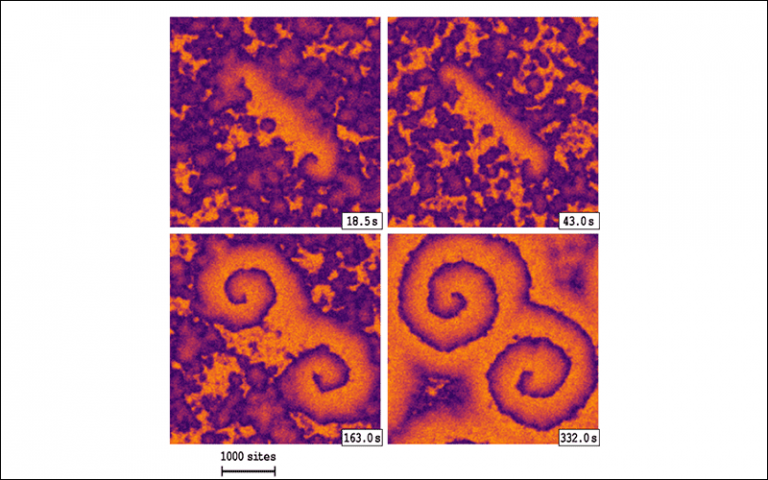Virtual Time and Graph-Theory for Stepping up Catalytic Materials Simulations
1 September 2021
Dr Stamatakis and co-workers have developed approaches that harness the power of supercomputers in the simulation of catalytic materials at unprecedented scales, enabling research towards greener, more efficient and more economical processes in the Chemical Industry.

Molecular simulations can provide unique insight into structure versus property relations, and accelerate the development of materials for diverse applications in e.g. electronics, structural mechanics or chemical technologies. Among the latter, a prominent example is the development of heterogeneous catalysts, solid materials that accelerate chemical reactions without being consumed in the process. Molecular simulation methods have offered fundamental understanding that has aided the development of novel, superior catalyst formulations; yet, under certain conditions these materials exhibit complex behaviour that can no longer be understood at the molecular level. An impressive example of such behaviour is the emergence of spiralling patterns (waves) in catalytic systems. For instance, such patterns, with wavelengths on the order of micro-metres, have been experimentally observed in the oxidation of carbon monoxide (CO) on platinum surfaces [cf. J. Chem. Phys. 98, 9977 (1993); https://doi.org/10.1063/1.464323], which is relevant to emissions control technologies.
In studying such “large” systems, molecular simulation approaches are simply too expensive and slow. Researchers have thus resorted to coarser macro-scale approaches to try to explain such phenomena, to the detriment, however, of fidelity and predictive capability. Bridging the molecular and macroscopic scales for the accurate simulation of materials is such a challenge, that the intermediate scale, known as the “meso-scale”, is still frequently referred to as “no-man’s land”. But this situation is about to change…
In a multi-year effort, researchers at UCL Chemical Engineering, in collaboration with the Research Software Development Group of the UCL Centre for Advanced Research Computing, have developed a kinetic Monte Carlo software implementation that enables the distributed simulation of meso-scale catalytic systems, with the use of hundreds or thousands of computing processors. Kinetic Monte Carlo approaches are known as “event-driven”, since they simulate a timeline of events, such as adsorption of reactant molecules on the catalytic surface, reactions, and desorption of products to the bulk phase. Since these events are causally linked (e.g. reaction cannot happen before molecules adsorb on the surface), performing this type of simulations with many processors is particularly challenging. If several such processors try to simulate concurrently events happening on different areas of the catalytic surface, they will eventually end up with conflicting timelines; thus, they would have to resolve all conflicts, in order to get the correct results.
The algorithmic mechanism that enables the correct resolution of these conflicts is based on the concept of Virtual Time and the pertinent approach is known as the Time-Warp algorithm. While in “traditional” kinetic Monte Carlo, simulated time moves only forward, in the Time-Warp algorithm it is treated in a flexible way. Thus, when employing e.g., 1000 processors in the simulation of a catalytic material, each processor can go back in time and make corrections to its timeline after receiving a signal about a conflict from another processor. Such corrections happen as many times as necessary during a distributed simulation, so that eventually all the processors generate mutually consistent timelines.
While the Time-Warp algorithm was devised back in the mid 80’s, its adoption in the materials modelling community has been hampered by the challenges in implementing and validating it in a general way, for simulated systems of arbitrary complexity. Dr Michail Stamatakis, the leader of this research effort, said: “The development of software Zacros has been a flagship project in our group for over 9 years. It was the first kinetic Monte Carlo software to use ideas from graph-theory for high-fidelity simulations of arbitrary reaction mechanisms on catalytic surfaces. UCL Business, the commercialisation company for UCL, has made the software available and is distributing it through online licensing platform XIP. Zacros has proven very popular among researchers. Our latest implementation makes it possible to use supercomputers with thousands of processors in such simulations and we have already achieved speedups of more than 1000 times in our benchmarks”. In addition, the researchers devised a “parallel-emulation” approach, i.e. a “traditional” kinetic Monte Carlo protocol (run on a single processor), which produces identical results as the parallel simulations, thereby validating the correctness of the implementation. The study was published online last week in Computer Physics Communications.
The coupling of the Time-Warp algorithm with the graph-theoretical Kinetic Monte Carlo framework within software Zacros opens up exciting new frontiers in the simulation of catalytic materials. It generates opportunities for closer-than-ever comparisons of theory with experiment, which, in addition to fundamental understanding, will yield novel insight for the design of catalysts at the mesoscale, towards more sustainable chemical processes and technologies.
Links
- Computer Physics Communications paper: Coupling the Time-Warp algorithm with the Graph-Theoretical Kinetic Monte Carlo framework for distributed simulations of heterogeneous catalysts
- Dr Michail Stamatakis academic profile
- Zacros
- Zacros on XIP
- UCL Centre for Advanced Research Computing
- UCL Business
Image credit
- Dr Michail Stamatakis
 Close
Close

